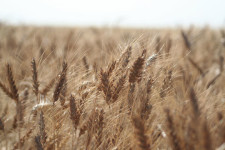Disease Resistance Priority For Wheat Checkoff Funding

For decades, Kansas State University’s Plant Pathology department has partnered with the Kansas Wheat Commission to provide wheat farmers the tools and techniques to combat common wheat diseases.
Kansas State University Plant Pathologist Bill Bockus uses Kansas Wheat Commission checkoff funds to generate disease resistance ratings and identify disease resistant lines of wheat. Through the 1.5 cent-per-bushel Kansas wheat checkoff, nearly $1.3 million in wheat research is conducted each year. In the field of plant pathology, researchers develop disease resistance, identify disease resistant lines of wheat and provide disease resistance ratings of new and existing varieties. Among them, Plant Pathologist Bill Bockus has a three-year project entitled, “Disease Phenotyping: Determining the Reaction of Wheat Lines to Important Diseases.”
The Kansas Wheat Commission contributes $30,000 annually to Bockus’ research, which includes operating the Kansas Intrastate Nursery. These are plots located throughout Kansas where Bockus inoculates advanced breeding lines – potential new wheat varieties – with a host of common plant diseases. He then checks (or phenotypes) these lines to see whether they possess disease resistance. Everest, K-State’s newest release, emerged from the nursery showing improved resistance to fusarium head blight and Barley Yellow Dwarf.
In 2011, BYD was the most devastating disease to the Kansas wheat crop, causing 30-50% yield loss in some fields throughout the state. The virus is spread by aphids or greenbugs and normally causes damage to fields in eastern Kansas; it just so happens that in 2010-11, these infestations were severe and widespread.
Diseases cost Kansas wheat farmers $380 million per year. The Hard Winter wheat plant pathology team, which includes researchers at K-State’s Manhattan campus, the K-State Ag Research Center in Hays and the USDA Ag Research Service in Manhattan, are working hard to solve these challenges. They have past success on which to build.
When Bockus came to K-State in 1978, central Kansas wheat farmers were routinely plagued by a fungus called Cephalosporium Stripe, which could reduce yields up to 50% in central Kansas, where it was most prevalent.
Bockus worked with wheat breeder Joe Martin to find resistance to the disease. That resulted in the variety Arkan, the first variety resistant to Cephalosporium Stripe. Now, Cephalosporium Stripe is practically non-existent, as is Wheat Soilborne Mosaic Virus, which met resistance in the variety, Newton. “That the number one disease that used to plague wheat in the 1970s is nearly gone is a huge success story,” Bockus says.
The great mystery behind plant pathology is that from one year to the next, researchers and farmers never know which disease will affect the state’s wheat crop. What you can be sure of is that wheat checkoff funds are invested into finding solutions to these disease challenges, and providing resources to researchers like Bockus to make that happen.
“Agriculture is one of the most exciting sciences in the world, because you’re doing something that directly impacts society. Everyone has to eat,” he says.






